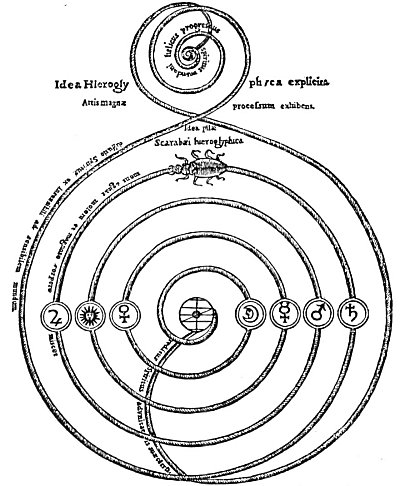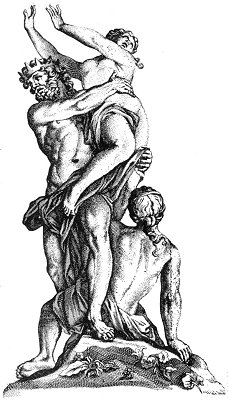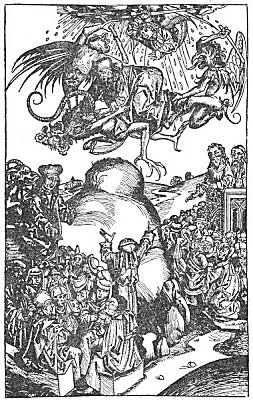Plutarch noted the fact that the scarab rolled its peculiar ball of dung backwards, while the insect itself faced the opposite direction. This made it an especially fitting symbol for the sun, because this orb (according to Egyptian astronomy) was rolling from west to east, although apparently moving in the opposite direction. An Egyptian allegory states that the sunrise is caused by the scarab unfolding
THE MANTICHORA.
From Redgrove’s Bygone Beliefs. The most remarkable of allegorical creatures was the mantichora, which Ctesias describes as having aflame-colored body, lionlike in shape, three rows of teeth, a human head and ears, blue eyes, a tail ending in a series of spikes and stings, thorny and scorpionlike, and a voice which sounded like the blare of trumpets. This synthetic quadruped ambled into mediæval works on natural history, but, though seriously considered, had never been seen, because it inhabited inaccessible regions and consequently was difficult to locate.
ROYAL EGYPTIAN SCARAB.
From Hall’s Catalogue of Egyptian Scarabs, Etc., in the British Museum. The flat under side of a scarab usually bears an inscription relating to the dynasty during which it was cut. These scarabs were sometimes used as seals. Some were cut from ordinary or precious stones; others were made of clay, baked and glazed. Occasionally the stone scarabs were also glazed. The majority of the small scarabs are pierced as though originally used as beads. Some are so hard that they will cut glass. In the picture above, A shows top and side views of the scarab, and B and B the under surface with the name of Men-ka-Ra within the central cartouche.
p. 87
its wings, which stretch out as glorious colors on each side of its body–the solar globe–and that when it folds its wings under its dark shell at sunset, night follows. Khepera, the scarab-headed aspect of Ra, is often symbolized riding through the sea of the sky in a wonderful ship called the Boat of the Sun.
The scorpion is the symbol of both wisdom and self-destruction. It was called by the Egyptians the creature accursed; the time of year when the sun entered the sign of Scorpio marked the beginning of the rulership of Typhon. When the twelve signs of the zodiac were used to represent the twelve Apostles (although the reverse is true), the scorpion was assigned to Judas Iscariot–the betrayer.
The scorpion stings with its tail, and for this reason it has been called a backbiter, a false and deceitful thing. Calmet, in his Dictionary of the Bible, declares the scorpion to be a fit emblem of the wicked and the symbol of persecution. The dry winds of Egypt are said to be produced by Typhon, who imparts to the sand the blistering heat of the infernal world and the sting of the scorpion. This insect was also the symbol of the spinal fire which, according to the Egyptian Mysteries, destroyed man when it was permitted to gather at the base of his spine (the tail of the scorpion).The red star Antares in the back of the celestial scorpion was considered the worst light in the heavens. Kalb al Akrab, or the heart of the scorpion, was called by the ancients the lieutenant or deputy of Mars. (See footnote to Ptolemy’s Tetrabiblos.) Antares was believed to impair the eyesight, often causing blindness if it rose over the horizon when a child was born. This may refer again to the sand storm, which was capable of blinding unwary travelers.
The scorpion was also the symbol of wisdom, for the fire which it controlled was capable of illuminating as well as consuming. Initiation into the Greater Mysteries among the pagans was said to take place only in the sign of the scorpion. In the papyrus of Ani (The Book of the Dead), the deceased likens his soul to a scorpion, saying: “I am a swallow, I am that scorpion, the daughter of Ra!” Elizabeth Goldsmith, in her treatise on Sex Symbolism, states that the scorpions were a “symbol of Selk, the Egyptian goddess of writing, and also [were] revered by the Babylonians and Assyrians as guardians of the gateway of the sun. Seven scorpions were said to have accompanied Isis when she searched for the remains of Osiris scattered by Set” (Typhon).

Moe is the founder of GnosticWarrior.com. He is a father, husband, author, martial arts black belt, and an expert in Gnosticism, the occult, and esotericism.

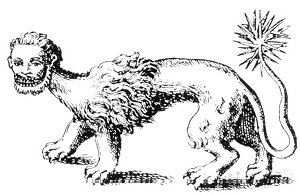

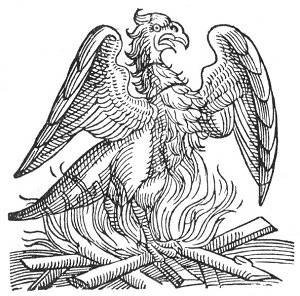



![How a little boy, dying in the same monastery, called upon a virgin that was to follow him; and how another nun, at the point of leaving her body, saw some small part of the future glory [675 A. D.?] | Book 4 | Chapter 8 How a little boy, dying in the same monastery, called upon a virgin that was to follow him; and how another nun, at the point of leaving her body, saw some small part of the future glory [675 A. D.?] | Book 4 | Chapter 8](https://www.gnosticwarrior.com/wp-content/plugins/contextual-related-posts/default.png)
